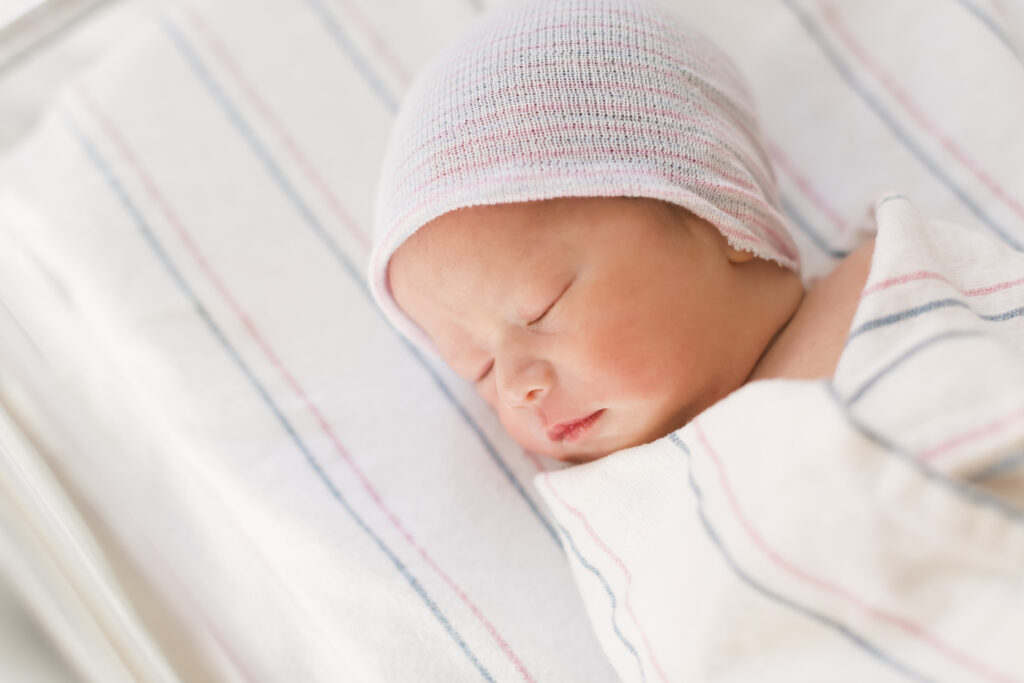Can Babies Be Born with Teeth?

Did you know that babies can be born with teeth? Natal teeth (i.e., teeth that are present at birth) are relatively rare, though less rare than you might think. Approximately one out of every 2,000 to 3,500 newborns comes into the world with at least one tooth.
But if you’re imagining a newborn smiling up at his mother with a full set of teeth, you should know that babies with natal teeth are usually born with no more than two teeth. A few babies have arrived with a much more substantial portion of their primary (“baby”) teeth present, but no cases of newborns with a full set of teeth have been reported.
Regardless of their number, natal teeth present special dental concerns and may require specialized care. In this article, we will discuss
- the difference between natal and neonatal teeth,
- characteristics of natal teeth,
- whether natal teeth are the same as baby teeth,
- causes of natal teeth,
- complications associated with natal teeth,
- when natal teeth should be removed, and
- considerations related to caring for natal teeth.
Differences Between Natal Teeth and Neonatal Teeth in Babies?
Whereas a natal tooth is present at birth, a neonatal tooth erupts during the first 30 days of an infant’s life. Natal and neonatal teeth present extremely similar issues and are generally studied and discussed together. The following information applies to both natal and neonatal teeth.
What Are Natal Teeth Like In Newborns?
In some cases, natal teeth look like normal primary teeth. Often, however, they are somewhat underdeveloped. For example, natal teeth may be smaller than normal primary teeth and/or cone-shaped. Their enamel (the tooth’s hard, protective outer coating) is often hypoplastic, meaning that it is thin or even absent; hypomineralized, meaning that the enamel is softer than normal; and/or hypomatured, resulting in tooth discoloration. Additionally, natal teeth typically have underdeveloped roots and are at least slightly mobile; sometimes their roots are so underdeveloped that the natal teeth fall out while the baby is still very young.
Just as with older babies, the lower central incisors (the bottom front teeth) are usually the first teeth to erupt in newborns. As described below, this can sometimes result in feeding issues.
Are Natal Teeth Primary Teeth?
Sometimes parents wonder whether natal teeth are a sort of temporary tooth that will fall out and then later be replaced by primary teeth. They are not.
The vast majority of natal teeth are simply ordinary primary teeth that erupt unusually early. The remainder are a type of tooth known as a supernumerary tooth. A full set of primary teeth consists of twenty teeth, but occasionally children grow more than twenty. These excess teeth are known as supernumerary teeth and can lead to overcrowding and bite issues.
Fewer than 10% of natal teeth are supernumerary teeth. A pediatric dentist can use dental X-rays to determine whether a natal tooth is supernumerary.
What Causes Natal Teeth?
The precise cause of natal teeth in newborns is unknown. Researchers have theorized that they may be a result of genetics, fever, infection or malnutrition, but so far no studies have been able to confirm the cause. Interestingly, various studies have reported that between 8% and 62% of infants with natal teeth had a positive family history.
Researchers have suggested that certain other medical conditions may be associated with natal teeth, including the following:
- Cleft lip and palate,
- Sotos syndrome,
- Ellis-van Creveld syndrome (chondroectodermal dysplasia),
- Hallermann-Streiff syndrome (oculomandibulofacial syndrome with hypotrichosis), and
- Jadassohn-Lewandowsky syndrome (congenital pachyonychia).
Cleft lip and palate may be the most common of the medical conditions associated with natal teeth, and the incidence of natal teeth among cleft lip and palate patients is significantly higher than among the general population. One study found that approximately 30% of the bilateral cleft lip and palate infants studied and 5% of the unilateral cleft lip and palate infants had natal or neonatal teeth. Another found that approximately 11% of the bilateral cleft lip and palate infants studied and 2% of the unilateral cleft lip and palate infants had natal or neonatal teeth.
Complications Associated with Natal Teeth
Aspiration Risk. Natal teeth that are highly mobile can fall out spontaneously and therefore may present an aspiration risk. The chances that a child will aspirate (i.e., inhale) a natal tooth is believed to be extremely low. However, because an aspirated tooth can cause potentially serious respiratory issues, including obstruction of the child’s airways, the possibility of aspiration should be considered.
Feeding Difficulties. Natal teeth can cause discomfort (for the baby and/or the mother) during nursing. In some cases, babies may develop an ulceration of the tongue known as traumatic lingual ulceration or Riga-Fede disease. This condition is often associated with lower incisor (bottom front) natal teeth. As natal teeth may be sharp and cone-shaped, movement of the tongue backward and forward during nursing can lead to an ulcer on the underside of the tongue. Riga-Fede disease typically presents as an open sore that can develop into a fibrous mass on the tongue, and it can make feeding painful or difficult for affected infants.
Crowding and Displacement. If the natal tooth is a supernumerary tooth, it may cause issues when the child’s other teeth come in. For example, supernumerary teeth can cause crowding issues and they can cause permanent teeth to come in incorrectly or to not come in at all.
Cavities. If the natal tooth has enamel hypoplasia or hypomineralization, it is at higher risk of developing cavities than a tooth without enamel defects.
Do Natal Teeth Need to Be Removed?
It depends. When natal teeth are supernumerary, they generally should be removed. Your child’s pediatric dentist can diagnose a supernumerary tooth and help determine the appropriate time for the extraction.
In contrast, when a natal tooth is part of the normal primary dentition (i.e., is one of a child’s twenty primary teeth), it is best to save the tooth when possible.
Primary teeth are extremely important – they help children to chew food and to speak clearly, and they help permanent teeth to come in correctly. And unlike missing permanent teeth, a missing primary tooth cannot be replaced with dental implants, as an implant can prevent the replacement permanent tooth from erupting properly. This means that, when a natal tooth that is part of the normal dentition is removed, the child will have to live without that tooth until the replacement permanent tooth comes in (typically six to twelve years, depending on the location of the tooth).
Natal teeth that are causing feeding difficulties can often be managed by grinding or polishing down any sharp edges on the tooth or by applying a small amount of composite resin (white filling material) over the tooth to smooth it. Smoothing out rough edges in this way may prevent trauma and allow ulcerations associated with Riga-Fede disease to heal.
That said, sometimes natal teeth removal is recommended. If smoothing down the tooth is not sufficient to eliminate feeding issues, extraction may be required. Additionally, natal teeth that are highly mobile are often extracted to prevent potential aspiration.
Extraction of natal teeth should be performed by a pediatric dentist who has familiarity with natal teeth. The extraction should be followed by removal of the soft tissue lining of the tooth socket in order to prevent continued root development.
Natal Teeth Management
Natal teeth that are not extracted may require special care and monitoring. Natal teeth with enamel defects are at increased risk for cavities. A pediatric dentist can teach you how to properly clean natal teeth and can closely monitor them for signs of decay.
Board-Certified Pediatric Dentist in DFW
If your child is born with natal teeth or grows teeth during the first month of life, visit a pediatric dentist right away. Hurst Pediatric Dentistry’s Dr. Lin is a board-certified pediatric dentist who has experience handling natal teeth. Call (817) 510-6400 today to book an appointment to learn how to care for your child’s natal teeth and to see whether any treatments are advisable.
Hurst Pediatric Dentistry is located in Hurst, Texas and serves pediatric patients from Hurst, Euless, Bedford, North Richland Hills, Keller, Colleyville, Southlake, Westlake, Fort Worth, Saginaw, The Colony and the surrounding area.
This article is intended to provide general information about oral health topics. It should not be used to diagnose or treat any medical condition or as a substitute for the advice of a healthcare professional who is fully aware of and familiar with the specifics of your case. Always seek the advice of your dentist or other qualified healthcare provider with regard to any questions you may have relating to a medical condition or treatment.
MEDICALLY REVIEWED BY:
Dr. Jin Lin

Dr. Jin Lin is a board-certified pediatric dentist with a passion for helping children achieve healthier, more beautiful smiles. He earned his Bachelor of Science degree from Cornell University and his Doctor of Dental Medicine (D.M.D.) degree from the Harvard School of Dental Medicine. After graduating cum laude from dental school, he completed his post-doctoral pediatric dentistry training at Boston Children’s Hospital and the Harvard School of Dental Medicine, where he served as chief resident and worked with children with a wide variety of special medical and dental needs, including children with rare syndromes.

